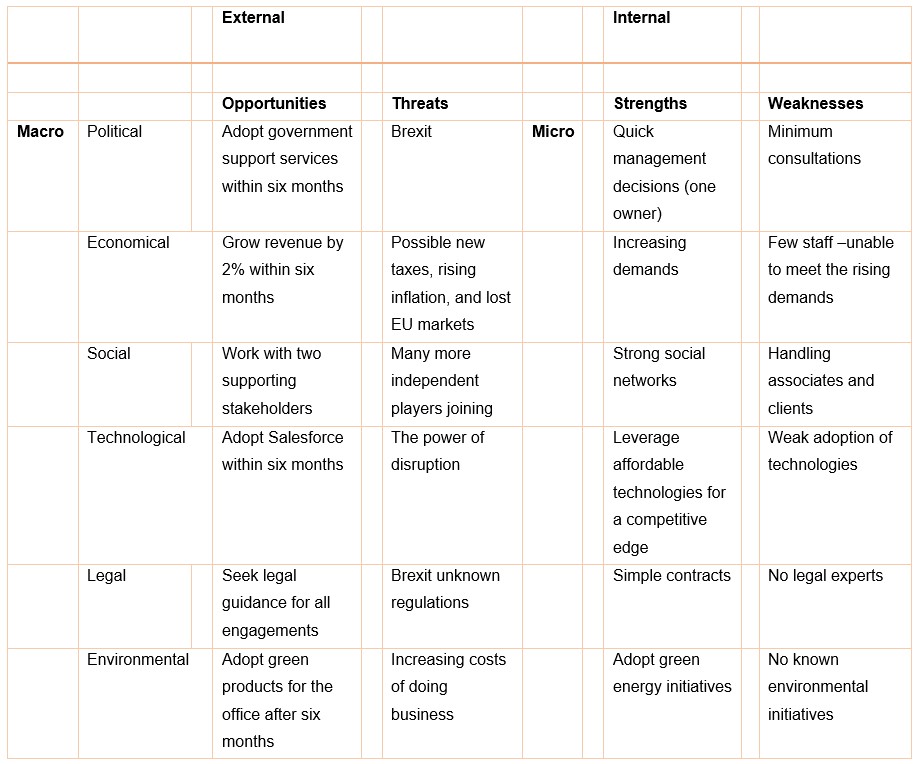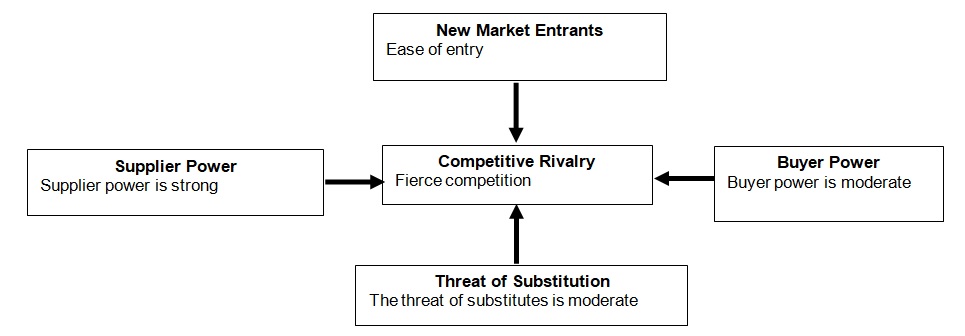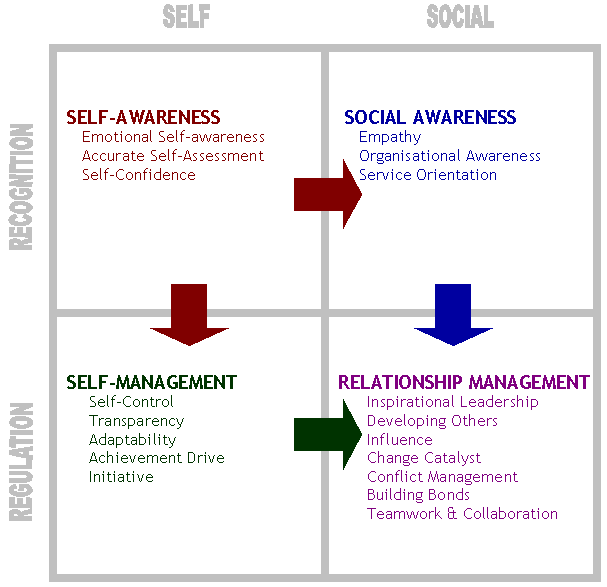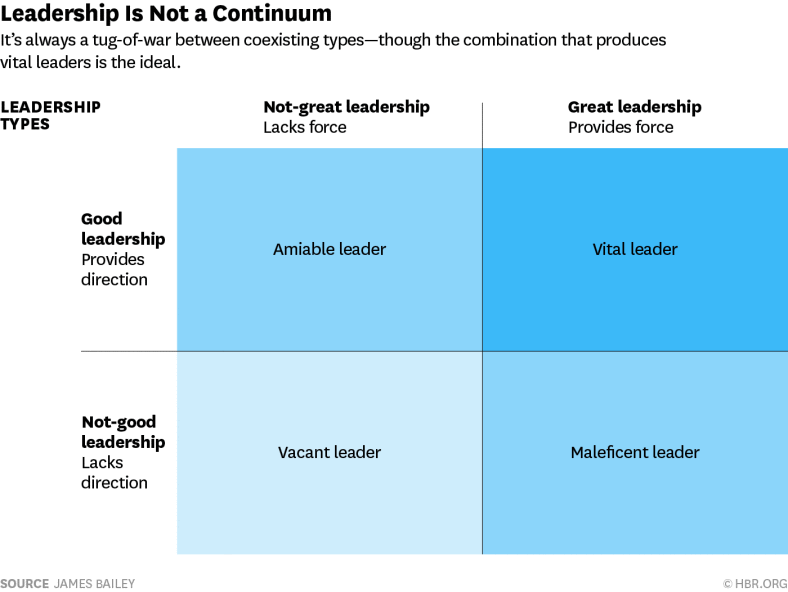The rationale for Choice of Training and Development Sector for Small Business Management in the UK
This assessment involves comprehensive research into a small business in the training and development sector for small businesses and producing a portfolio addressing a rationale for the choice of small business training and development, a critical focus on potential benefits and challenges of operating a small business, entrepreneurial processes responsible for the success of the business and a personal reflection on the research undertaken. It is imperative to recognize that this assessment is based on specific analytical tools such as PESTLE, VRIN, Blue Ocean, the Ansoff Matrix, and Daniel Goleman’s five components of emotional intelligence and vital leader continuum.
The small business chosen for this assessment is B Consultancy Ltd. Leep Academy is the charitable arm of the B Consultancy. This small consultancy firm claims over 12 years of experience in the enterprise, employability, and skills sector, according to information available on its website (B Consultancy Ltd 2017). B Consultancy generally works with start-ups and flourishing entrepreneurs, supporting and advancing them to ensure their survival and development. The company believes in strong relationships with its stakeholders; it strives to build partnerships in Europe, across the UK, and at the local level to assist a great many individuals who wish to venture into business. The company uses tailored training, workshops, and mentoring programs specifically geared to drive self-employment and helps clients to acquire skills, talents, and genuine ability to run their ventures. B Consultancy currently serves locations in London, Kent, and Essex.
The role of small businesses in the UK cannot be underestimated. According to the National Federation of Self Employed & Small Businesses Limited (FSB), in the year 2016, small businesses accounted for 99.3% of all private businesses, and they were mainly small or medium-sized (SMEs). The FSB further shows that small businesses were responsible for about 15.7 million jobs, reflecting 60% of all employment in the UK private sector (National Federation of Self Employed & Small Businesses Limited 2016a). Small businesses also have had a significant impact on the economy. Their aggregated annual turnover in 2016 was about £1.8 trillion, accounting for 47% of the private sector turnover in the UK in that year. Notably, the number of such businesses has risen by 2.0 million since 2000 and by 97,000 between 2015 and 2016, and they continue to employ more workforce (employing businesses) or offer direct employment to owners.
Small businesses in the UK, like everywhere else, face many management challenges, and of particular interest to this assessment is the widening knowledge, expertise, and skills gaps that adversely affect these businesses in the UK. Nearly 75% of small ventures in the UK accept a deficiency of skills among their employees, which hurts business growth and profitability (Vorbach 2016; Jordans Limited 2013). Skills gaps are noted in IT, marketing and sales, management and leadership, and project management capacities, which stifle innovation, competitiveness, employee retention, and morale, and eventually the growth of the sector (Vorbach 2016). Findings demonstrate that a skills gap in leadership and management stifles productivity in the UK, especially among small businesses (National Federation of Self Employed & Small Businesses Limited 2016b). Organizations fail to implement the right strategies to advance their strategic objectives and goals. Evidence shows that small businesses do not prioritize employee training and development (Wilkinson 2016; National Federation of Self Employed & Small Businesses Limited 2016b).
The need to offer the right skills, leadership and management abilities to employees and owners of small businesses in the UK has led to a rise in demand for training and development services because of growth opportunities in the UK (Sabatier 2016). However, it is imperative to recognize that this sector is highly fragmented and characterized by small businesses and independent freelance trainers and coaches. Hence, firms such as B Consultancy have the chance to maximize emerging opportunities to meet this rising demand.
A Critical Analysis and Discussion of the Benefits and Potential Challenges
The Supply Chain Management
Supply chain management reflects how B Consultancy controls all processes involved in delivering all services to clients to create a competitive advantage and improve performance (Li et al. 2006). B Consultancy focuses on sufficient training and development resources, at the preferred levels of quality, on time, for the right clients, in the right place, and at competitive prices. It aims to understand the needs of its customers; determine the most appropriate training needs; how much of a service is required within a given period; determine the number of associates to engage; secure training resources from the right suppliers at reasonable costs; and set and maintain service quality standards in the industry.
Benchmarking
For B Consultancy, would focus on:
- Operational excellence benchmarking evaluates operational effectiveness across three distinct areas: cost, risk, and service (Bain & Company 2015)
- Innovation benchmarking assesses the company’s capabilities to create value using novel approaches (PwC 2017).
- Information technology (IT) benchmarking assists the company to understand IT investment and related impacts.
- Human resource metrics for workforce productivity, controls, quality of associates, turnover of associates, and efficiency.
- Sourcing excellence benchmarking is applied in supply chain management.
- Finance effectiveness benchmarking involves costs and related revenues.
Financial Planning
For B Consultancy, financial planning is all about forecasting (Credit Suisse Group AG 2016). First, the income statement forecast helps it to determine possible expenses, incomes, and profits. Second, the balance sheet forecast assists the company to assess asset values and financial situations. Third, the cash flow forecast determines the impacts of intended investments and financing methods. Finally, liquidity forecasting is applied to understand how B Consultancy would ensure liquidity.
PESTLE

Political Factors
The UK is a generally stable country with no political risks, and the current government strives to support small businesses using various means. For instance, under the National Apprenticeship Services, small businesses receive assistance to develop the necessary skills and capacity of their employees (Lewis 2014).
Janice Beckles of B Consultancy observes Brexit presents “opportunities for collaboration and innovation also for businesses to enter new markets”. Brexit has led to doubts concerning the status of EU nationals living in the UK and, thus, hindering the free movement of human capital (Gardiner 2016). Organizations cannot plan their human resources (HR) into the future.
Economic Factors
Sustained economic growth at approximately 2% for the next five years following Brexit. The low inflation rate will support small businesses, while a rise in interest rates would deter growth (ICAEW 2016). New regulatory environments and taxes would negatively affect small businesses, such as VAT, income tax, and a national minimum wage. Conversely, low property costs, workforce skills, favorable government policies, access to infrastructure (airport), and technology (broadband speed) favor small business growth (Lobel 2016).
Social Factors
Beckles observes that enterprise support and training are widely available, and small businesses that have encouraged their staff to acquire skills from many ILM organizations will succeed in an increasingly competitive market. Beckles concurs that the government, private sector, and other not-for-profit organizations offer supports to small businesses (Lewis 2014). However, she notes that these stakeholders have failed to work with other organizations at the grassroots.
Technological Factors
The availability of technologies, including high broadband speed, facilitates the growth of small businesses (Lobel 2016). Technology also presents threats to consultancy firms because of the democratization of information, fewer intermediaries, and the rise of machine learning – the power of disruption (Osak 2015; Consultancy.uk 2017).
Legal Factors
The UK has one of the most efficient judicial systems in the world. Intellectual property rights are protected, and the justice system is not subject to external influences (Heritage Foundation 2017). Hence, small businesses have been able to thrive under such supporting systems.
Environmental Factors
Small businesses are striving for sustainability by reducing energy consumption, water conservation, and conserving materials like papers (Matthews 2015).
The VRIN in Consultancy Business
The resource-based view (RBV) claims that valuable, rare, inimitable resources and organization (VRIO) create a competitive advantage (Cardeal & António 2012). In the consultancy business, firms rely heavily on human capital to create value for their clients and establish a competitive edge.
B Consultancy thrives because of its human resources; a review of Janice’s resume and qualifications of her associates reveals this fact (Knott 2015). Human capital at the company reflects all the elements of VRIN (value generation, rarity, inimitability, and organizational support).
Blue Ocean and Ansoff’s Product/Market Matrix
According to Beckles, the consultancy environment is characterized by clients who pay late and associates who have their agenda and pick off key clients for their purposes. More importantly for small firms, the Blue Ocean section of the market is the unchallenged market segment in which competition is irrelevant (Reeder n.d).
The Eliminate-Reduce-Raise-Create Grid (ERRC).
ERRC shows B Consultancy should eliminate multiple courses and concentrate on key areas, transfer mentoring and coach to business. It should reduce meetings, which consume much time, but adopt technology-driven services. It should raise individualized training and development and other services to improve outcomes.
The Ansoff’s Matrix.
It is helpful to link Blue Ocean and the approach involved in Ansoff’s product/market matrix as a way to consider opportunities of Blue Ocean growth for a firm using these aspects of Ansoff.
Product Development – B Consultancy develops consultancy products and services that appeal to the market (Consultancy.uk 2017).
Market Development – B Consultancy concentrates on the UK market to create a competitive edge using its human resources.
Diversification – realize growth by developing new consultancy and support services for completely new markets, perhaps after Brexit.
Market Penetration (Red Ocean) – competing fiercely in the current market, beating the competition, focusing on the growing demands from small businesses and entrepreneurs, and creating value against the cost for customers.
B Consultancy must find ways to support its diversification efforts using market penetration strategies and available capabilities to push the boundaries of current known markets.
Porter’s Five Forces of Competitive Position

In the case of B Consultancy, an assessment of the company’s competitive strategies and Porter’s choices can reveal some interesting findings (Consultancy Group 2007). The issue of entry into the field of management consultancy and support services is noted as having limited barriers, implying that many more freelance consultants may enter the industry. The CEO should therefore have sufficient time to evaluate unknown markets and new products (e.g. Salesforce for customer management and growth using marketing and customer service features) to determine the best market spaces that could offer relatively higher returns. Based on Brexit, for instance, Beckles will have to watch the market, review the business plan, understand changes in customers’ needs and adapt quickly to deliver services, IT solutions, operations, and organizational structures that respond to these needs.
How B Consultancy can Integrate Salesforce into its Core Business Strategy
The ultimate resource for Beckles to adopt Salesforce is to support the growth strategy and create a competitive edge for B Consultancy using the human resource. Salesforce is among the leading customer relationship management (CRM) tools for small businesses. It ensures efficiency and profitability due to increased sales, more lead generation, and enhanced customer service. It affects many operations in a company.
B Consultancy offers multiple services to its clients: start-up and enterprise; start-up loans; e-learning; business for success training; CPD for advisors and coaches; neuro-linguistic programming; coaching; mentoring; project management; short courses; facilitation; business plans; and business training for organizations. All these services need to be delivered seamlessly in different ways using human capital at B Consultancy. As B Consultancy has grown over the last 12 years, the services naturally are delivered based on divergent priorities. As such, B Consultancy may have challenges coordinating all these activities with associates and customers. There could be missing reports, poor tracking of services, and poor management of workflow.
The solution lies in the deployment of Salesforce to support current growth strategies. Adopting Salesforce would assist B Consultancy to ensure that data are centralized and accessible by eliminating the silo effect while accommodating increments. Beckles can now deploy Salesforce to manage customers’ contacts and track programs. Reports and services’ charts can be so readily available. Additionally, B Consultancy would concentrate on service outcome measures to demonstrate the impacts of each service offered.
The case of OverDrive shows how companies can leverage Salesforce and ReadyTalk to create a competitive advantage. Companies now use webinars to generate leads and change them into sales. However, some firms have been able to achieve much more by integrating webinars and CRM systems. Data from webinars are used to generate leads and sales (Frost & Sullivan n.d). For instance, planning any webinar events require much time. B Consultancy, however, can save time and cost by integrating Salesforce and ReadyTalk for sending e-mail invites, collecting registration generate new leads, and capturing attendance data automatically in Salesforce. Hence, Salesforce would help B Consultancy to eliminate manual data entry. Moreover, streamlined business processes attributed to improved automation, reporting, and workflow all integrated into a cloud-based platform would improve reporting, analytics, and monitor customers’ accounts while reducing the previous heavy workload. B Consultancy would also have performance metrics based on reviews to promote growth.
Identification and Evaluation of the Team-Building Efforts and Entrepreneurial Processes that Contribute to the Success of B Consultancy
A primary part of the CEO’s job is nurturing and keeping the team together (Robbins 2010). It has been observed that the behavior of people is determined generally by previous experiences and not necessarily by what lies ahead (Greiner 1998). Beckles has been made redundant twice and opted to start her firm. She notes that her leadership and management styles are autocratic and democratic respectively. She prefers associates who are low-maintenance and can get on with the task. The CEO also likes to set the direction of the company and will ultimately make the final decision, sometimes based on gut instinct, but she does ask others their opinions and will consider their ideas. Her work offers flexibility, a variety of work, and diverse goals to achieve, and, therefore, she prefers being vigilant, having the right people doing the right roles, and collaborating.
Beckles understands that unless there is a strong team at the top, the business will not be successful. She must always know how to select, manage and lead the top associates at the company because they are the source of competitive advantage in the industry.
Beckles’ team is made up of individuals who can perform functional, executive, and leadership roles (Matthews 2001). Her team must display capabilities for managing operations, meeting executive roles, and helping the CEO to meet some of her roles and responsibilities. For a firm to grow, the CEO must concentrate on strategy and the business plan. The team should be able to perform day-to-day operations to allow the CEO to focus on strategic objectives rather than operations. Additionally, the CEO expects the team to collaborate, work as a team and be growth-oriented individuals.

Based on Daniel Goleman’s five components of emotional intelligence, Beckles is grouped under social skills reflected in relationship management. She can identify social cues to develop a favorable environment, manage relations with associates and create networks with different organizations and individuals within and outside the industry. The CEO displays emotional maturity about communication that can be noted in listening and appropriate responses, influence, and leadership on the team by providing direction and managing possible conflicts with associates and clients who pay late (Beard 2012).
On the vital leader continuum, Beckles can be classified under ‘good leadership’ because she provides direction. She is an amiable leader and wants to see her company thrive based on her direction and support from associates.

Customer satisfaction at B Consultancy is relatively high. Beckles understands that her consultancy firm runs on customers. Now more than ever before, the firm continuously relies on its customers for repeat businesses, referrals, and growth. Beckles strives to engage customers and potential ones at every opportunity using social media tools (B Consultancy Ltd 2017). Constant communication makes customers feel more respected and valued while Beckles demonstrates that her firm can deliver all services promised. Collecting customer feedback, monitoring changes in the industry, and assessing competition is important for the company. Besides, Beckles understands that training and development and offering other support services require flexibility because one size does not fit all in terms of needs and costs. Beckles also works with some of the best associates in the industry to protect the reputation of the company. Customers are now more demanding and want value for their money and, therefore, Beckles understands this and certainly strives to deliver the best.
The current industry is highly fragmented and characterized by well-established multinationals, regional, locals, and numerous independent players. As such, it is highly competitive. Based on the competitive landscape, consultancy firms have developed various strategies to create a competitive advantage. The large consultancy firms, for instance, have established themselves as a one-stop-shop service for each consulting need a client may have. Hence, they strive for long-lasting customer relationships and opportunities to cross-sell various services. Although majorities of smaller and medium-sized firms and independent consultants have specialized in specific areas of expertise such as human resources, startups, or business recovery, B Consultancy strives to create a one-stop-shop and cross-sell its wide range of services like other large firms do. Using this approach, B Consultancy has grown significantly in the last 12 years, although it cannot command the same fees as other multinationals. B Consultancy competes for highly qualified, experienced associates to offer the best.
Growth objectives and profitability for B Consultancy focus on knowledge and knowledge management to ensure optimal use of available human capital to support internal capabilities. The firm is constantly monitoring the environment to advance innovation, as it seeks new solutions for emerging issues. B Consultancy also focuses on reputation and quality work because of clients’ perceptions. Moreover, the strategy should now focus on developing a network of partners to support numerous services offered. The company’s profitability is most likely to be realized from long-term customer engagements and cost-savings from innovations.
Critical Personal Reflection on the Research Undertaken
I researched and wrote my work on small business management in the UK. This research aimed to contribute to the knowledge base about the role of small businesses in the UK. We had to select a suitable company for this project, but I realized that research is a complex process that requires prior planning. My topic was informed by the guidelines provided by the choice of the small business, but choosing an entrepreneur for an interview was entirely my decision. Although there was no clearly defined path to accomplishing this research project, I started with the review of past learning materials and theories in the field to give me some insights into the field of strategic business management.
I settled on B Consultancy because of the rise of the firm in the competitive training and development field. Notably, it was not simply to gather data as scheduled because Janice Beckles was always occupied with other tasks.
From my experiences, this research project undertaken gave me unique opportunities to observe the business environment and determine how it impacts small businesses in the UK. The most interesting part of this research was to apply strategic analytical tools to real-life experiences and understand how entrepreneurs use them. Hence, I had to evaluate and reflect on various tools, such as VRIN, Porter’s five forces, PESTEL, Blue Ocean, Red Ocean, and resource-based view.
It was also important for me to develop a rapport with my respondent. We managed to collaborate throughout the project, as I learned about her work. The interview was a perfect opportunity for me to capture the industry knowledge and conceptualize it in the project. I managed to develop a significant awareness of the industry, but more importantly, I got reliable results that informed my entire work. Consequently, I was able to develop greater comprehension of the small business work environment based on guidelines from various theoretical concepts.
Another critical observation during this research project was the collection of relevant materials to the course. The works by others, including scholars, professionals, and organizations, provided a solid foundation upon which I could refer and compare with my findings. The available resource materials were extremely informative. I owe a lot to Janice Beckles who took her valuable time to respond to my interview questions. Her contribution will form a part of future literature that would be available for others to use.
During this research, I gained important insights into entrepreneurship. First, mentors and coaches are vital for successful entrepreneurship, most entrepreneurs have acquired adequate experience from other jobs before initiating their businesses and entrepreneurship is somewhat like a calling. Effective leadership, teamwork, support from different stakeholders, favorable environments (internal and external), and the ability of an entrepreneur to understand and apply strategic analytical tools are extremely important for success. Overall, I can state that I am utterly satisfied and excited about my accomplishment and looking forward to new learning experiences.
Reference List
B Consultancy Ltd 2017, About us.
Bain & Company 2015, Benchmarking.
Beard, M 2012, 5 main components of emotional intelligence.
Cardeal, N & António, N 2012, ‘Valuable, rare, inimitable resources and organization (VRIO) resources or valuable, rare, inimitable resources (VRI) capabilities: what leads to competitive advantage?’, Academic Journals, vol. 6, no. 37, pp. 10159-10170. Web.
Consultancy.uk 2017, Trends and challenges in the management consulting industry.
Consultancy Group 2007, Competitive landscape of management consulting.
Credit Suisse Group AG 2016, Financial planning at a glance, Web.
Frost & Sullivan n.d., Webinars can improve business processes, Web.
Gardiner, B 2016, ‘Never mind Brexit trade deals for big business, it’s small businesses we need to be worried about’, Independent.
Greiner, LE 1998, ‘Evolution and revolution as organizations grow’, Harvard Business Review.
Heritage Foundation 2017, 2017 index of economic freedom. Web.
ICAEW 2016, UK economy biggest concern for businesses in 2016, says ICAEW, Web.
Jordans Limited 2013, SMEs fear skills gap could hit profits, Web.
Knott, PJ 2015, ‘Does VRIO help managers evaluate a firm’s resources?’, Management Decision, vol. 53, no. 8, pp. 1806-1822, doi: 10.1108/MD-08-2014-0525.
Lewis, C 2014, ‘How the government can help your small business’, The Telegraph.
Li, S, Ragu-Nathan, B, Ragu-Nathan, TS & Subba Rao, S 2006, ‘The impact of supply chain management practices on competitive advantage and organizational performance’, Omega, vol. 34, no. 2, pp. 107–124. Web.
Lobel, B 2016, Small businesses propping up the UK economy.
Matthews, J 2001, A top team is key to growth, Web.
Matthews, R 2015, Why small businesses are engaging sustainability, Web.
National Federation of Self Employed & Small Businesses Limited 2016a, Boosting leadership and management in small firms, Web.
National Federation of Self Employed & Small Businesses Limited 2016b, UK small business statistics: business population estimates for the UK and regions in 2016.
Osak, M 2015, ‘How consulting companies remain competitive in changing times’, Financial Pos.
PwC 2017, Benchmarking. Web.
Reeder, T n.d., Blue ocean growth.
Robbins, S 2010, Advanced entrepreneurship: teaming up for success, Harvard Business Review.
Sabatier, M 2016, ‘Why executive coaching is back in vogue’, Training Journal.
Vorbach, T 2016, Widening skills gap adversely affecting UK SME growth, Web.
Wilkinson, H 2016, ‘Small UK firms not investing in management training despite poor productivity’, Business Advic.